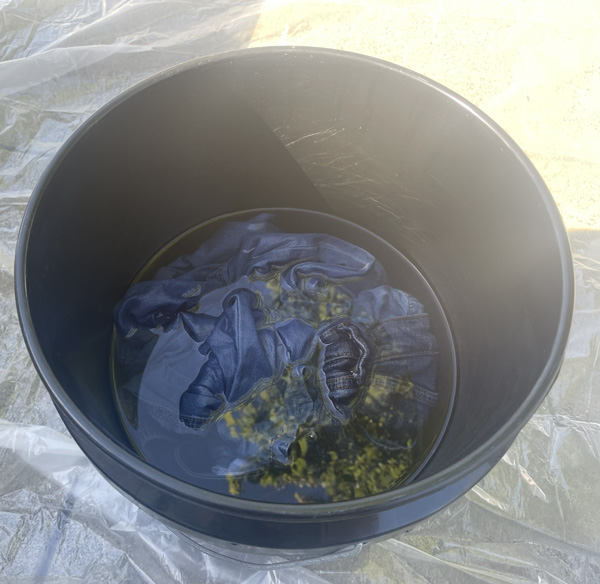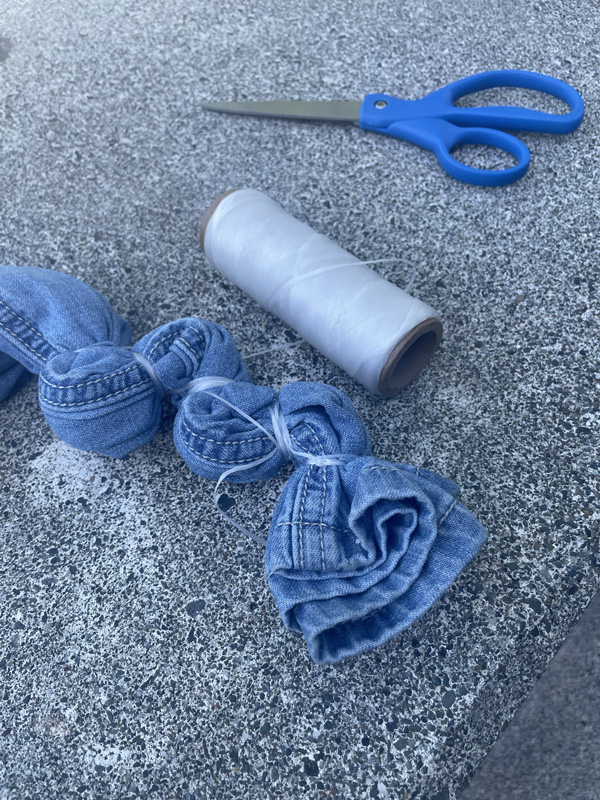
Fixer Uppers: Re-Blue that Denim with Indigo Tutorial
a Dharma featured tutorial
Denim, the classic staple that can be found in almost everyone's wardrobe either as a pair of jeans, skirts, overalls or jackets. Indigo is the traditional dye used to dye the yarns woven into denim fabric, it allows for the slow wear and fade that denim is known for. Sometimes we want to refresh that color without losing this mellowing quality, which is what would happen with more wash fast dyes such as Fiber Reactive Dyes or other grocery store brands. Here is how to restart your denim and continue the fades.Shopping list:
- Jacquard Indigo Dye Kit
- Old Jeans, jackets or other denim items
- Optional Additions:
- Scrap fabric - make some indigo fabric patches for mending your denim
- Rubber Bands
- Sinew
- Zip Ties
- 5 Gallon Buckets
- Dharma Dyerâ€â„¢s Detergent
Let's get started!

Make sure your garments are pre-washed with some Dharma Dyer's Detergent so there is no fabric softener etc. to impede the dyeing process. If your items are clean but dry, put them to soak in clean water while getting the indigo vat ready.

Pro-Tip- Run your garments through the spin cycle in the washer to remove excess water.
From the Jacquard Indigo Kit Instructions
Setting up the indigo vat:
- Fill a 5 gal/18.93 L bucket with 4 gal/15.14 L warm tap water.
- Empty the indigo dye packet into the water. Stir.
- While stirring, slowly empty the Soda Ash and reducing agent packets into the water.
- Gently, but thoroughly stir the vat in a one direction circular motion. Once the vat is well mixed slow down and reverse the direction of the stirring as you drag the stir stick along the outer edge of the vat before slowly removing it. Cover the vat with a lid and allow it to settle for at least 15 minutes to 1/2 hour. For best results, wait one hour.
- After the vat has settled, remove the lid. The top of the dye bath may be covered with thin blue skin (rather than the traditional foamy "flower"). Wearing gloves, gently move it to the side. The dye bath should be a clear yellow or yellow-green color under the flower. If it's not, wait another 1/2 hour and check again.
Dyeing:
- Squeeze out the extra water from your garment. Fold, tie or bind your garment or fiber. If you want a more solid color, leave it open/unfolded.
- When you are ready to begin dyeing, remove the cover from the vat. If there is a layer of thin blue skin on top, then gently move it to the side while wearing gloves.
- Squeeze excess water and air out of your fabric.
- While still squeezing your fabric, slowly submerge your piece into the dye vat. Once submerged gently manipulate the piece to ensure that the dye will penetrate the unbound parts evenly. You may work the piece in the vat underneath the surface for one to several minutes in this way. Do not drop the fabric in the vat and let it sink to the bottom. There will be residue that has settled on the bottom of the vat and you don't want to stir that up while you are dyeing. The residue can cause spots on your dyed piece.
Pro-Tip- Tie a line of sinew to your folded bundle if you want to leave it for a long soak, you can tie it off to keep it off the bottom of the vat without having to hold it the whole time.

- When you are ready to take the fabric out of the vat, squeeze it just below the surface as you slowly remove it from the vat. You want to prevent splashing as this introduces oxygen back into the vat. The fabric will be the same yellow green of the vat. Slowly, the fabric will begin to turn blue as the oxygen in the air contacts it. Place the cover over the container.
- Set aside the fabric to allow the piece to completely oxidize. You may want to turn the piece an
- Once the item has oxidized you can either repeat steps 4 - 6 to achieve darker shades of blue or you can rinse excess indigo from the piece, untie, and wash with a mild detergent and warm water.
Pro-Tip- The general idea in keeping an indigo vat is that you want to keep the vat as oxygen free as possible. That is why not splashing and squeezing excess air from the fabric is important.
- Store the vat in an area where the temperature will remain between 68-85° F / 20-29° C, a comfortable room temperature.
- Keep out of reach of children and animals.
- Always store with the lid on the container.


If you want to make a larger vat or try some other indigo vat recipes check out these options
- Traditional Indigo Shibori Basics
- Indigo Recipe Based on Michel Garcia's 1-2-3 Vat-
- Natural (non pre-reduced) Indigo Vat
- Iron Indigo Vat
- Fiber Reactive Dye âہ“Indigo†- doesnâ€â„¢t fade the same over time but some might prefere that











